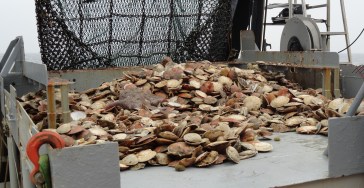NOAA Teacher at Sea
Carol Glor
Aboard R/V Hugh R. Sharp
July 5 – 14, 2014
Mission: Sea Scallop Survey (Third leg)
Geographical Area: Northwest Atlantic Ocean
Date: July 7, 2014
Weather Data from the bridge: Wind SW 18-20 knots, Seas 4-7 ft, Visibility – good
Science and Technology Log: Starring the HabCam
The HabCam is a computerized video camera system. It is a non-invasive method of observing and recording underwater stereo images, and collecting oceanographic data,such as temperature,salinity, and conductivity. The vehicle is towed at 1.5 – 2 meters from the floor of the ocean. The main objective of this mission is to survey the population of scallops as well as noting the substrate (ocean floor make-up) changes. Most substrate is made up of sand, gravel, shell hash and epifauna. We also note the presence of roundfish (eel, sea snakes, monkfish, ocean pout, and hake), flatfish (flounders and fluke), whelk, crab, and skates. Although sea stars (starfish) are a major predator of scallops, they are not included in our annotations.

The crew and science staff work on alternate shifts (called watches) to ensure the seamless collection of data. The scallop survey is a 24-hour operation. The science component of the ship consists of 11 members. Six people are part of the night watch from 12am-12pm and the remaining members (myself included) are assigned to the day watch which is from 12pm until 12am. During the HabCam part of the survey all science staff members rotate job tasks during their 12-hour shift. These include:
A. Piloting the HabCam – using a joystick to operate the winch that controls the raising and lowering of the HabCam along the ocean floor. This task is challenging for several reasons. There are six computer monitors that are continually reviewed by the pilot so they can assess the winch direction and speed, monitor the video quality of the sea floor, and ensure that the HabCam remains a constant 1.5 – 2 meters from the ocean floor. The ocean floor is not flat – it consists of sand waves, drop-offs, and valleys. Quick action is necessary to avoid crashing the HabCam into the ocean floor.

B. The co-pilot is in charge of ensuring the quality of digital images that are being recorded by the HabCam. Using a computer, they tag specific marine life and check to see if the computers are recording the data properly. They also assist the pilot as needed.

C. Annotating is another important task on this stage of the survey. Using a computer, each image that is recorded by the HabCam is analyzed in order to highlight the specific species that are found in that image. Live scallops are measured using a line tool and fish, crabs, whelk and skates are highlighted using a boxing tool so they can be reviewed by NOAA personnel at the end of the cruise season.
Personal Log:
When not on watch there is time to sleep, enjoy beautiful ocean views, spot whales and dolphins from the bridge (captain’s control center), socialize with fellow science staff and crew members, and of course take lots of pictures. The accommodations are cozy. My cabin is a four-person room consisting of two sets of bunk beds, a sink, and desk area. The room is not meant to be used for more than sleeping or stowing gear. When the ship is moving, it is important to move slowly and purposely throughout the ship. When going up and down the stairs you need to hold onto the railing with one hand and guide the other hand along the wall for stability. This is especially important during choppy seas. The constant motion of the ship is soothing as you sleep but makes for challenging mobility when awake.


Before heading out to sea it is important to practice safety drills. Each person is made aware of their muster station (where to go in the event of an emergency), and is familiarized with specific distress signals. We also practiced donning our immersion suits. These enable a person to be in the water for up to 72 hours (depending upon the temperature of the water). There is a specific way to get into the suit in order to do so in under a minute. We were reminded to put our shoes inside our suit in a real life emergency for when we are rescued. Good advice indeed.


Did you know?
The ship makes it’s own drinking water. While saltwater is used on deck for cleaning purposes, and in the toilets for waste removal, it is not so good for cooking, showers, or drinking. The ship makes between 600 and 1,000 gallons per day. It is triple-filtered through a reverse-osmosis process to make it safe for drinking. The downside is that the filtration system removes some important minerals that are required for the human body. It also tends to dry out the skin; so using moisturizer is a good idea when out at sea.
Photo Gallery:






























































